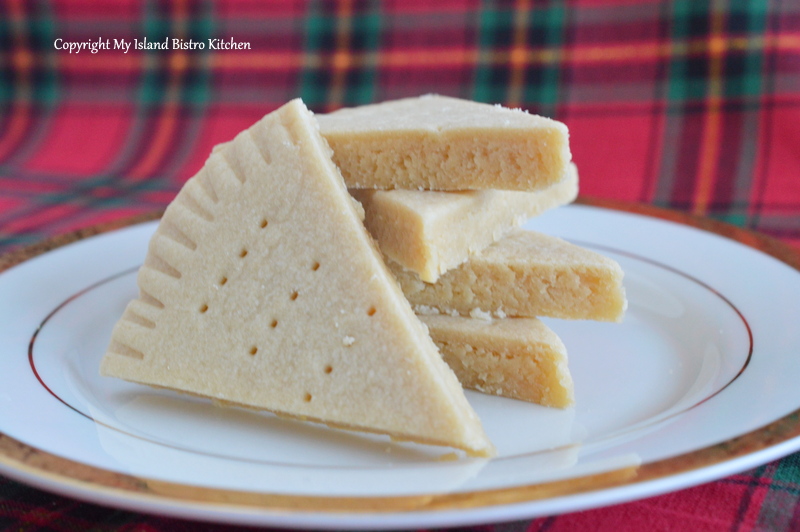
While some will argue that Shortbread is not a cookie per se, I chose to include it in my Cookie of the Month series I ran a few years ago and, at the time of original writing, featured it for January given that is the month Robert Burns Day is celebrated. There are so many recipes and versions (and opinions!) of Shortbread and what follows is mine.
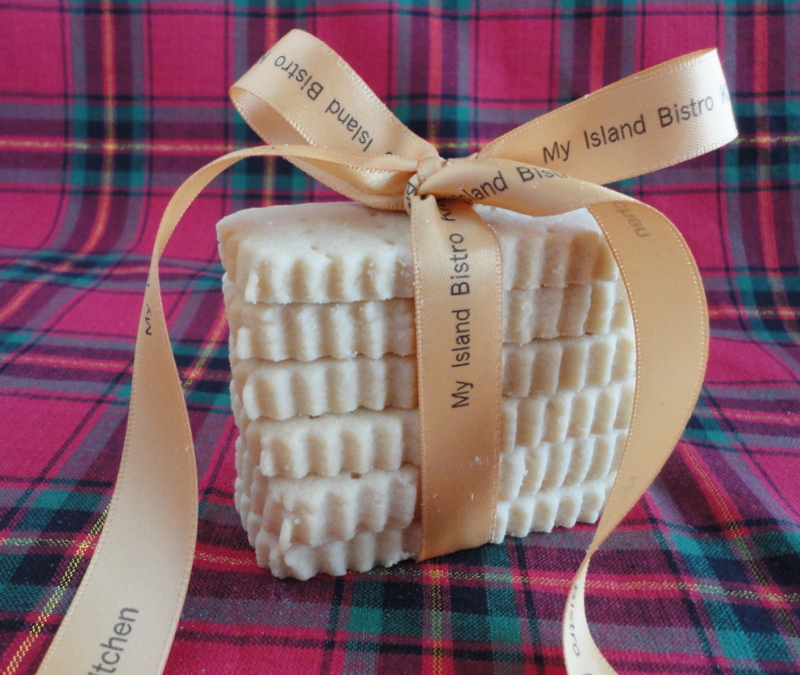
This perfectly plain, delicate treat attributes, I believe, its origin to Scotland.

Shortbread is relatively easy to make and does not take a lot of ingredients or ones not likely to be found in most kitchens. Recipe ingredients do vary, however. You will find that, in addition to some kind of fat, sugar, and flour, some recipes call for the addition of cornstarch, confectioner’s or brown sugar, salt, egg yolk, and/or vanilla. Other recipes call for a 50/50 mix of butter and shortening. I have even seen some recipes list cream of tartar and/or baking soda as ingredients. Shortbread purists, however, are likely to argue that, technically, there are only supposed to be three ingredients in traditional shortbread – 1 part sugar, 2 parts butter, and 3 parts flour and no leavening agent or other flavourings.
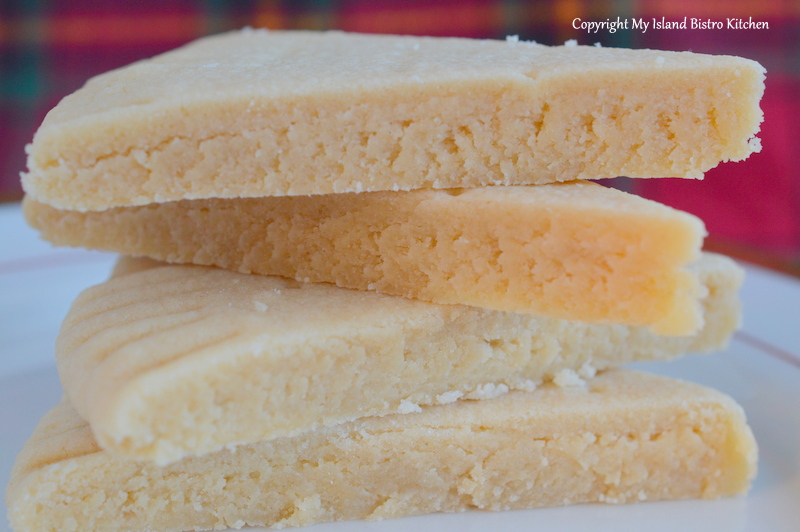
Everything about quality Shortbread focuses on high quality ingredients so that you get that melt-in-your-mouth sensation with just one bite into a piece of Shortbread. I use pure creamery butter, no substitutes . I find it is important that the butter be at room temperature so it will cream better. Do not soften the butter in the microwave as it breaks it down too quickly and it becomes liquefied which may alter the texture of the dough.
My recipe calls for brown sugar so the Shortbread made from this recipe will be a little darker in color than if white sugar or confectioner’s sugar is used. I do take some liberties with my Shortbread recipe and I add an egg yolk because I find it helps to bind the ingredients together and gives the Shortbread a nice texture. I also add a pinch of salt and sometimes – but not always — some vanilla. If using vanilla, make sure it is pure and not artificially flavoured.
What determines the quality of a good Shortbread is how “short” it is. When you bite into a Shortbread, it should crumble easily and you should be able to taste the butter flavour as the Shortbread slowly melts in your mouth. You won’t get that if you use a mixture of butter and shortening or all margarine, for example.
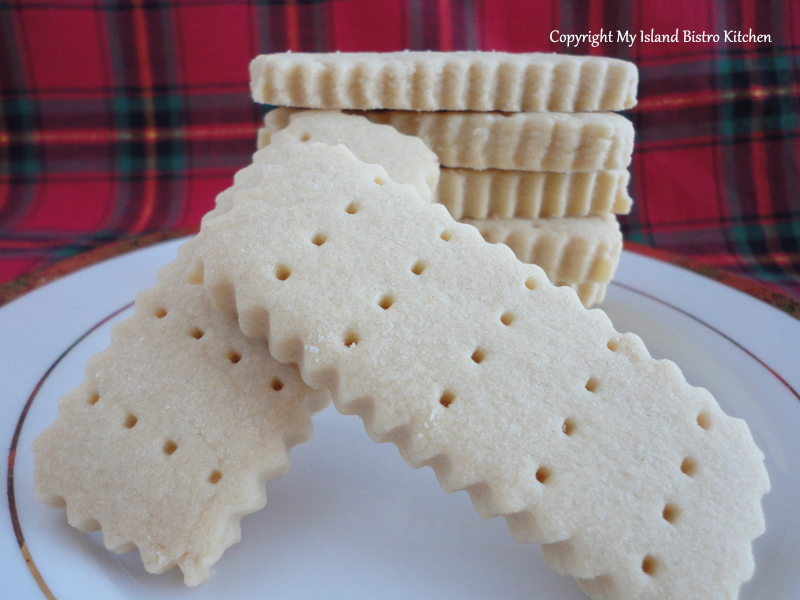
I like the dough in this recipe – it holds together well, does not take a lot of kneading to incorporate all the ingredients and prepare it for rolling, rolls out without cracking or breaking apart, and almost has a satin-like feel to it.
Shortbread dough should only be minimally kneaded – just enough for it to stick together and allow it to be rolled out for cutting. I don’t find chilling the dough before rolling it out and cutting out the shapes is generally necessary with this particular recipe; however, if your kitchen is particularly warm or if you find the dough too soft to roll out and cut shapes from, then place the dough in the fridge for 15-20 minutes or so to allow it to firm up.
I do, however, recommend that the cut-out shapes of the Shortbread be refrigerated on their baking sheet(s) for 20-30 minutes before baking them. This will firm up the softened butter used in the Shortbread. This will slow down the melting of the butter in the Shortbread when it hits the hot oven and which could cause some spreading of the cut-out shapes. Taking the few extra minutes to refrigerate the cut-out Shortbread shapes will provide extra assurance that the Shortbread will maintain a consistent and uniform shape.
I don’t like super-thick Shortbread so I roll the dough to a scant ¼” thickness. Of course, I always use parchment paper for cookie baking and the Shortbread should be baked in a slow (300F) oven so it won’t burn or scorch. With the high butter content, baking Shortbread in a hot oven will run the risk of burning or turning the Shortbread too dark in color.
Today, I have divided the dough, making part of the recipe into Shortbread fingers using a traditional rectangular-shaped shortbread cookie cutter 1” wide by 3” long. For the remainder of the dough, I rolled it into about a 7” circle and, using the tip of a sharp knife, scored the dough into 8 wedges. Don’t cut all the way through; just score it lightly on the top. You can use the tines of a fork to press lightly the outside edge of the circle and also to prick the surface of the dough into a decorative pattern. Once the Shortbread is removed from the oven, immediately cut all the way through the score marks and separate the wedges which are often called “petticoat tails”.
My Island Bistro Kitchen’s Favourite Shortbread
Ingredients:
1 cup butter (no substitutes), room temperature
½ cup brown sugar
1 egg yolk, room temperature
1 tsp vanilla (optional)
2 cups flour
Pinch salt (optional)
Method:
In bowl of stand mixer fitted with paddle attachment, beat the butter on high speed until light and fluffy (2-3 minutes). Add the sugar and beat until smooth, scraping the bowl as necessary. Add the egg yolk and vanilla. Beat until incorporated. With mixer on slow speed, stir in the flour and salt just until mixed.
Line cookie sheet(s) with parchment paper and preheat oven to 300F.
Turn dough onto lightly-floured surface. Gently knead dough just until it holds together. Do not over-knead. Shape dough into a round mound. If dough is too soft to roll and cut, refrigerate it for 15-20 minutes. Roll dough to approximately ¼” thickness. Cut into desired shapes.
Place shortbread about 1” apart on parchment-lined baking sheet. Refrigerate for 20-30 minutes then bake in preheated oven for 20 minutes. Remove from oven and let shortbread rest on baking sheet for approximately 5 minutes then transfer to wire rack to cool. Makes approximately 30 (1” x 3” rectangles).
If desired, dough may be rolled into small 6” or 7” circles and scored with the tip of a sharp knife into wedges. When shortbread is removed from the oven, immediately cut through scored lines to separate the wedges.

The Shortbread will keep for about a week in an airtight container at room temperature. Also freezes well.
Pin Me To Pinterest!
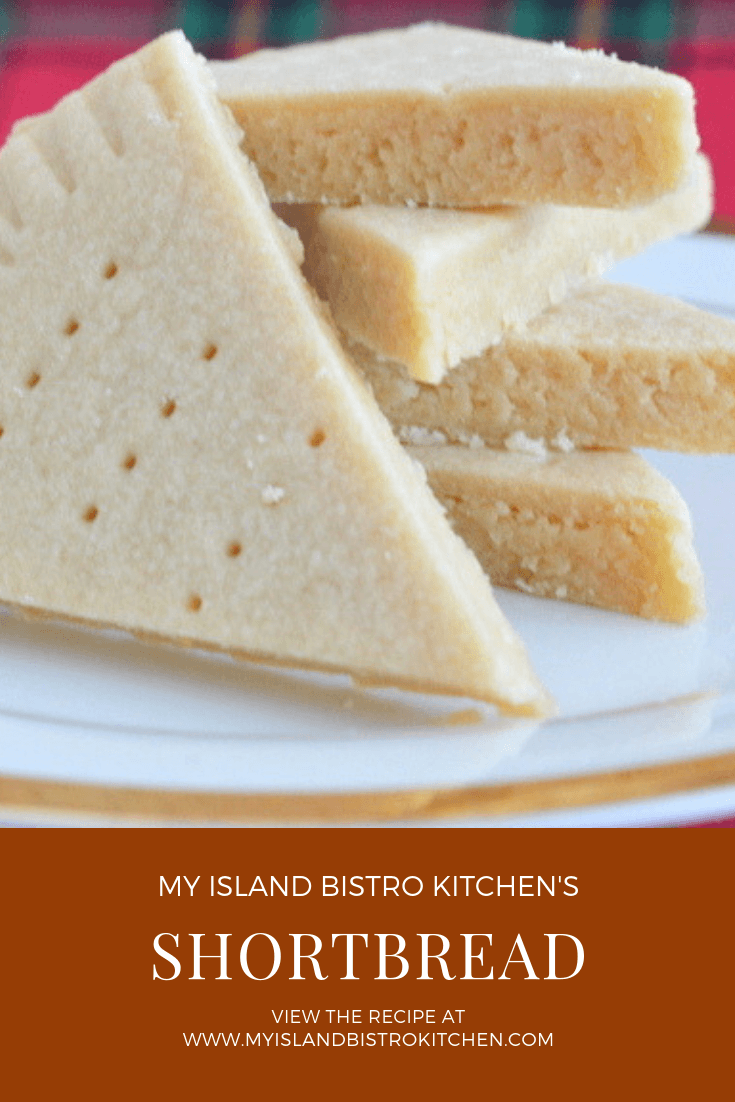
If you have made this recipe and enjoyed it and/or wish to share it with your friends and family, please do so on social media but be sure to share the direct link to this posting from my website.
Connect with My Island Bistro Kitchen on Social Media
Join the Facebook page for My Island Bistro Kitchen: https://www.facebook.com/MyIslandBistroKitchen/
Follow “the Bistro” on “X” (formerly Twitter): https://twitter.com/PEIBistro/
See the drool-worthy gallery of mouth-watering food photos from My Island Bistro Kitchen on Instagram: https://www.instagram.com/peibistro/
Follow “the Bistro” on Pinterest at https://www.pinterest.ca/peibistro/ and pin the Pinterest-ready photo at the end of this posting to your favorite Pinterest boards!
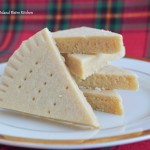
My Island Bistro Kitchen’s Favourite Shortbread
Ingredients
- 1 cup butter (no substitutes), room temperature
- ½ cup brown sugar
- 1 egg yolk, room temperature
- 1 tsp vanilla (optional)
- 2 cups flour
- Pinch salt (optional)
Instructions
- In bowl of stand mixer fitted with paddle attachment, beat the butter on high speed until light and fluffy (2-3 minutes). Add the sugar and beat until smooth, scraping the bowl as necessary. Add the egg yolk and vanilla. Beat until incorporated. With mixer on slow speed, stir in the flour and salt just until mixed.
- Preheat oven to 300°F.
- Turn dough onto lightly-floured surface. Gently knead dough just until it holds together. Do not over-knead. Shape dough into a round mound. If dough is too soft to roll, refrigerate it for 15-20 minutes. Roll dough to approximately ¼” thickness. Cut into desired shapes.
Place shortbread about 1” apart on parchment-lined baking sheet. Refrigerate for 20-30 minutes then bake in preheated oven for 20 minutes. Remove from oven and let shortbread rest on baking sheet for approximately 5 minutes then transfer to wire rack to cool. Makes approximately 30 (1” x 3” rectangles).
- If desired, dough may be rolled into small 6” or 7” circles and scored with the tip of a sharp knife into wedges. When shortbread is removed from the oven, immediately cut through scored lines to separate the wedges.
- The shortbread will keep for about a week in an airtight container at room temperature. Also freezes well.
Recipe Notes
Copyright My Island Bistro Kitchen
You may also enjoy these other shortbread style confections from My Island Bistro Kitchen:
Scotch Cookies
Gluten-free Earl Grey Cranberry-Orange Shortbread
Lemon Spritz Shortbread Cookies
Melting Moments
Custard Sandwich Cookies
Gluten-free Melting Moments
Snowball Cookie Balls
The Rumrunners – Rum and Raisin Cookies
This post was last updated December 6, 2023


